Analysis of Accounting Concepts and Qualitative Characteristics Report
VerifiedAdded on 2023/06/18
|6
|1295
|211
Report
AI Summary
This report delves into the fundamental accounting concepts used in preparing financial statements, including the matching concept, duality aspect, business entity concept, accrual concept, and going concern concept, providing examples of their application. It also examines the qualitative characteristics of financial reports, such as relevance, faithful representation, verifiability, comparability, timeliness, and understandability, which enhance the usefulness of financial information for users. The report references academic journals and online resources to support its analysis of these key accounting principles and reporting qualities.
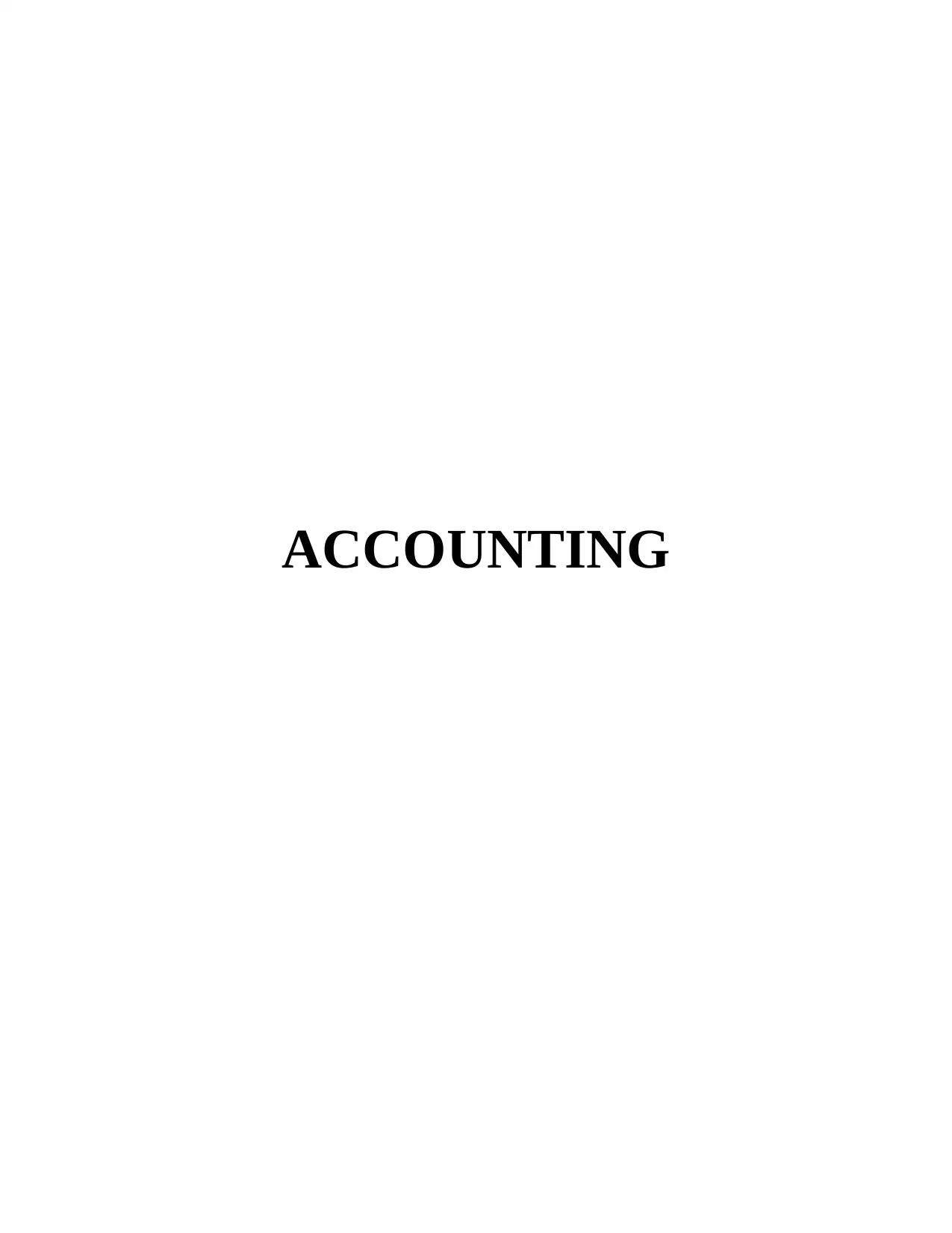
ACCOUNTING
Paraphrase This Document
Need a fresh take? Get an instant paraphrase of this document with our AI Paraphraser
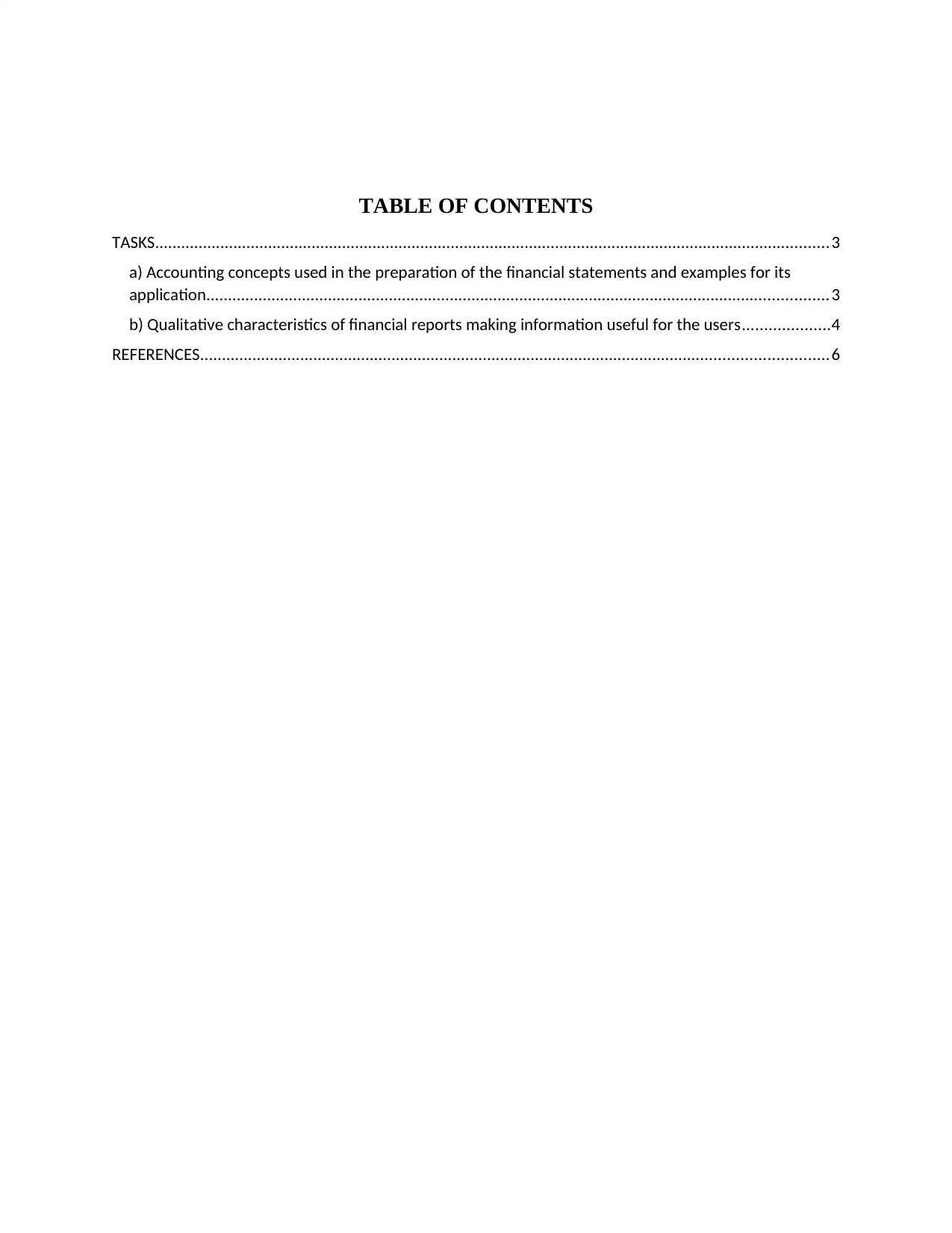
TABLE OF CONTENTS
TASKS...........................................................................................................................................................3
a) Accounting concepts used in the preparation of the financial statements and examples for its
application...............................................................................................................................................3
b) Qualitative characteristics of financial reports making information useful for the users....................4
REFERENCES................................................................................................................................................6
TASKS...........................................................................................................................................................3
a) Accounting concepts used in the preparation of the financial statements and examples for its
application...............................................................................................................................................3
b) Qualitative characteristics of financial reports making information useful for the users....................4
REFERENCES................................................................................................................................................6
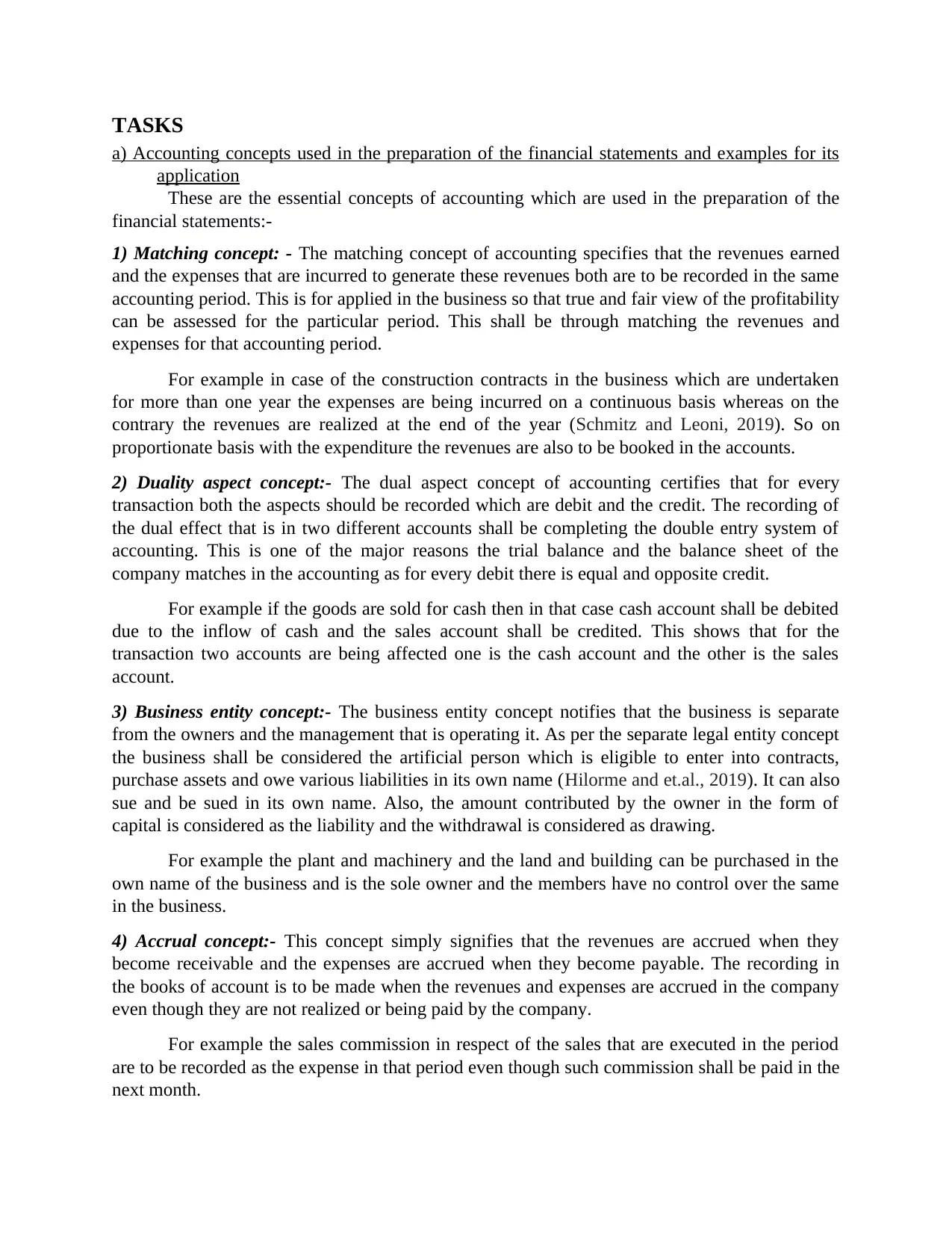
TASKS
a) Accounting concepts used in the preparation of the financial statements and examples for its
application
These are the essential concepts of accounting which are used in the preparation of the
financial statements:-
1) Matching concept: - The matching concept of accounting specifies that the revenues earned
and the expenses that are incurred to generate these revenues both are to be recorded in the same
accounting period. This is for applied in the business so that true and fair view of the profitability
can be assessed for the particular period. This shall be through matching the revenues and
expenses for that accounting period.
For example in case of the construction contracts in the business which are undertaken
for more than one year the expenses are being incurred on a continuous basis whereas on the
contrary the revenues are realized at the end of the year (Schmitz and Leoni, 2019). So on
proportionate basis with the expenditure the revenues are also to be booked in the accounts.
2) Duality aspect concept:- The dual aspect concept of accounting certifies that for every
transaction both the aspects should be recorded which are debit and the credit. The recording of
the dual effect that is in two different accounts shall be completing the double entry system of
accounting. This is one of the major reasons the trial balance and the balance sheet of the
company matches in the accounting as for every debit there is equal and opposite credit.
For example if the goods are sold for cash then in that case cash account shall be debited
due to the inflow of cash and the sales account shall be credited. This shows that for the
transaction two accounts are being affected one is the cash account and the other is the sales
account.
3) Business entity concept:- The business entity concept notifies that the business is separate
from the owners and the management that is operating it. As per the separate legal entity concept
the business shall be considered the artificial person which is eligible to enter into contracts,
purchase assets and owe various liabilities in its own name (Hilorme and et.al., 2019). It can also
sue and be sued in its own name. Also, the amount contributed by the owner in the form of
capital is considered as the liability and the withdrawal is considered as drawing.
For example the plant and machinery and the land and building can be purchased in the
own name of the business and is the sole owner and the members have no control over the same
in the business.
4) Accrual concept:- This concept simply signifies that the revenues are accrued when they
become receivable and the expenses are accrued when they become payable. The recording in
the books of account is to be made when the revenues and expenses are accrued in the company
even though they are not realized or being paid by the company.
For example the sales commission in respect of the sales that are executed in the period
are to be recorded as the expense in that period even though such commission shall be paid in the
next month.
a) Accounting concepts used in the preparation of the financial statements and examples for its
application
These are the essential concepts of accounting which are used in the preparation of the
financial statements:-
1) Matching concept: - The matching concept of accounting specifies that the revenues earned
and the expenses that are incurred to generate these revenues both are to be recorded in the same
accounting period. This is for applied in the business so that true and fair view of the profitability
can be assessed for the particular period. This shall be through matching the revenues and
expenses for that accounting period.
For example in case of the construction contracts in the business which are undertaken
for more than one year the expenses are being incurred on a continuous basis whereas on the
contrary the revenues are realized at the end of the year (Schmitz and Leoni, 2019). So on
proportionate basis with the expenditure the revenues are also to be booked in the accounts.
2) Duality aspect concept:- The dual aspect concept of accounting certifies that for every
transaction both the aspects should be recorded which are debit and the credit. The recording of
the dual effect that is in two different accounts shall be completing the double entry system of
accounting. This is one of the major reasons the trial balance and the balance sheet of the
company matches in the accounting as for every debit there is equal and opposite credit.
For example if the goods are sold for cash then in that case cash account shall be debited
due to the inflow of cash and the sales account shall be credited. This shows that for the
transaction two accounts are being affected one is the cash account and the other is the sales
account.
3) Business entity concept:- The business entity concept notifies that the business is separate
from the owners and the management that is operating it. As per the separate legal entity concept
the business shall be considered the artificial person which is eligible to enter into contracts,
purchase assets and owe various liabilities in its own name (Hilorme and et.al., 2019). It can also
sue and be sued in its own name. Also, the amount contributed by the owner in the form of
capital is considered as the liability and the withdrawal is considered as drawing.
For example the plant and machinery and the land and building can be purchased in the
own name of the business and is the sole owner and the members have no control over the same
in the business.
4) Accrual concept:- This concept simply signifies that the revenues are accrued when they
become receivable and the expenses are accrued when they become payable. The recording in
the books of account is to be made when the revenues and expenses are accrued in the company
even though they are not realized or being paid by the company.
For example the sales commission in respect of the sales that are executed in the period
are to be recorded as the expense in that period even though such commission shall be paid in the
next month.
⊘ This is a preview!⊘
Do you want full access?
Subscribe today to unlock all pages.

Trusted by 1+ million students worldwide
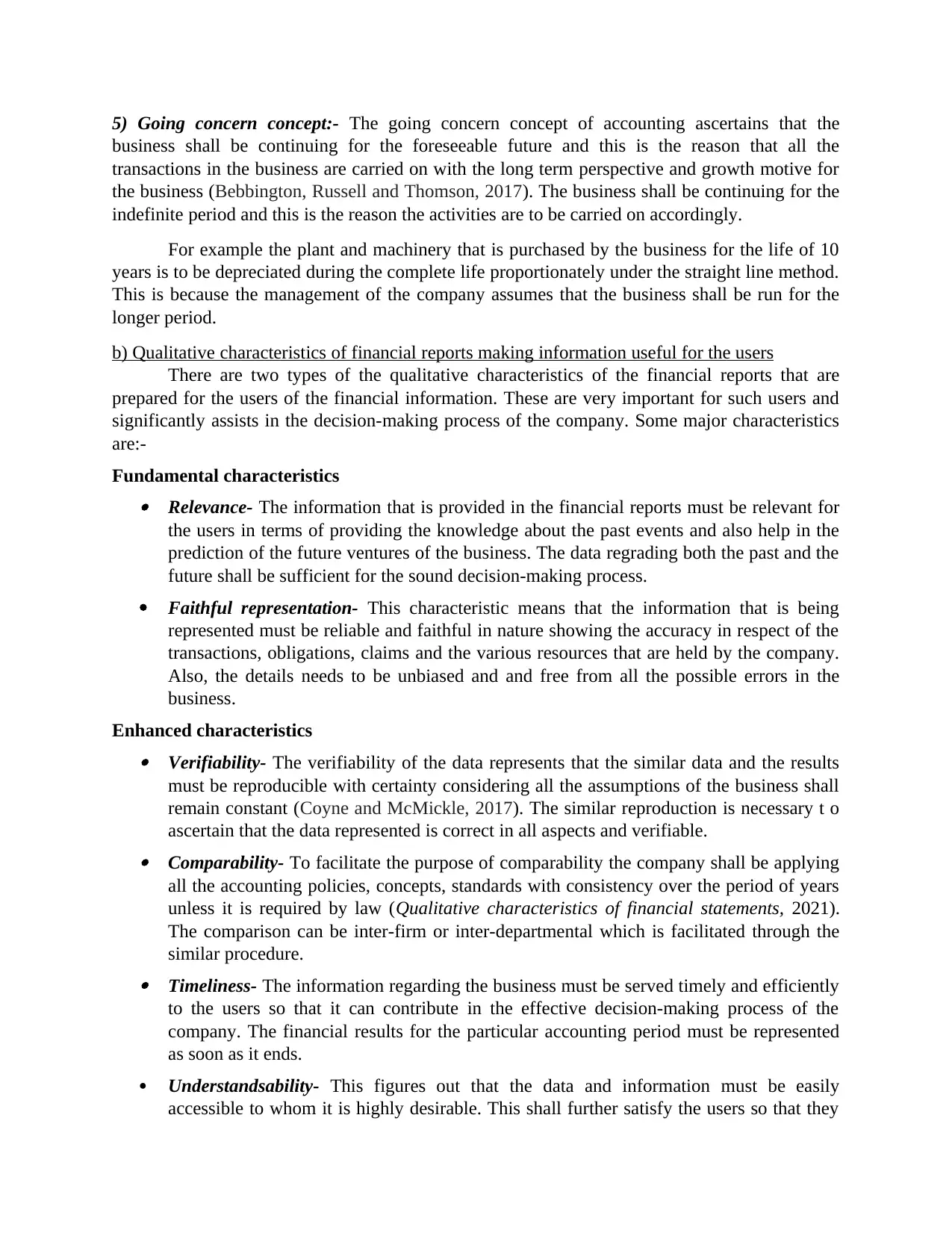
5) Going concern concept:- The going concern concept of accounting ascertains that the
business shall be continuing for the foreseeable future and this is the reason that all the
transactions in the business are carried on with the long term perspective and growth motive for
the business (Bebbington, Russell and Thomson, 2017). The business shall be continuing for the
indefinite period and this is the reason the activities are to be carried on accordingly.
For example the plant and machinery that is purchased by the business for the life of 10
years is to be depreciated during the complete life proportionately under the straight line method.
This is because the management of the company assumes that the business shall be run for the
longer period.
b) Qualitative characteristics of financial reports making information useful for the users
There are two types of the qualitative characteristics of the financial reports that are
prepared for the users of the financial information. These are very important for such users and
significantly assists in the decision-making process of the company. Some major characteristics
are:-
Fundamental characteristics Relevance- The information that is provided in the financial reports must be relevant for
the users in terms of providing the knowledge about the past events and also help in the
prediction of the future ventures of the business. The data regrading both the past and the
future shall be sufficient for the sound decision-making process.
Faithful representation- This characteristic means that the information that is being
represented must be reliable and faithful in nature showing the accuracy in respect of the
transactions, obligations, claims and the various resources that are held by the company.
Also, the details needs to be unbiased and and free from all the possible errors in the
business.
Enhanced characteristics Verifiability- The verifiability of the data represents that the similar data and the results
must be reproducible with certainty considering all the assumptions of the business shall
remain constant (Coyne and McMickle, 2017). The similar reproduction is necessary t o
ascertain that the data represented is correct in all aspects and verifiable. Comparability- To facilitate the purpose of comparability the company shall be applying
all the accounting policies, concepts, standards with consistency over the period of years
unless it is required by law (Qualitative characteristics of financial statements, 2021).
The comparison can be inter-firm or inter-departmental which is facilitated through the
similar procedure. Timeliness- The information regarding the business must be served timely and efficiently
to the users so that it can contribute in the effective decision-making process of the
company. The financial results for the particular accounting period must be represented
as soon as it ends.
Understandsability- This figures out that the data and information must be easily
accessible to whom it is highly desirable. This shall further satisfy the users so that they
business shall be continuing for the foreseeable future and this is the reason that all the
transactions in the business are carried on with the long term perspective and growth motive for
the business (Bebbington, Russell and Thomson, 2017). The business shall be continuing for the
indefinite period and this is the reason the activities are to be carried on accordingly.
For example the plant and machinery that is purchased by the business for the life of 10
years is to be depreciated during the complete life proportionately under the straight line method.
This is because the management of the company assumes that the business shall be run for the
longer period.
b) Qualitative characteristics of financial reports making information useful for the users
There are two types of the qualitative characteristics of the financial reports that are
prepared for the users of the financial information. These are very important for such users and
significantly assists in the decision-making process of the company. Some major characteristics
are:-
Fundamental characteristics Relevance- The information that is provided in the financial reports must be relevant for
the users in terms of providing the knowledge about the past events and also help in the
prediction of the future ventures of the business. The data regrading both the past and the
future shall be sufficient for the sound decision-making process.
Faithful representation- This characteristic means that the information that is being
represented must be reliable and faithful in nature showing the accuracy in respect of the
transactions, obligations, claims and the various resources that are held by the company.
Also, the details needs to be unbiased and and free from all the possible errors in the
business.
Enhanced characteristics Verifiability- The verifiability of the data represents that the similar data and the results
must be reproducible with certainty considering all the assumptions of the business shall
remain constant (Coyne and McMickle, 2017). The similar reproduction is necessary t o
ascertain that the data represented is correct in all aspects and verifiable. Comparability- To facilitate the purpose of comparability the company shall be applying
all the accounting policies, concepts, standards with consistency over the period of years
unless it is required by law (Qualitative characteristics of financial statements, 2021).
The comparison can be inter-firm or inter-departmental which is facilitated through the
similar procedure. Timeliness- The information regarding the business must be served timely and efficiently
to the users so that it can contribute in the effective decision-making process of the
company. The financial results for the particular accounting period must be represented
as soon as it ends.
Understandsability- This figures out that the data and information must be easily
accessible to whom it is highly desirable. This shall further satisfy the users so that they
Paraphrase This Document
Need a fresh take? Get an instant paraphrase of this document with our AI Paraphraser
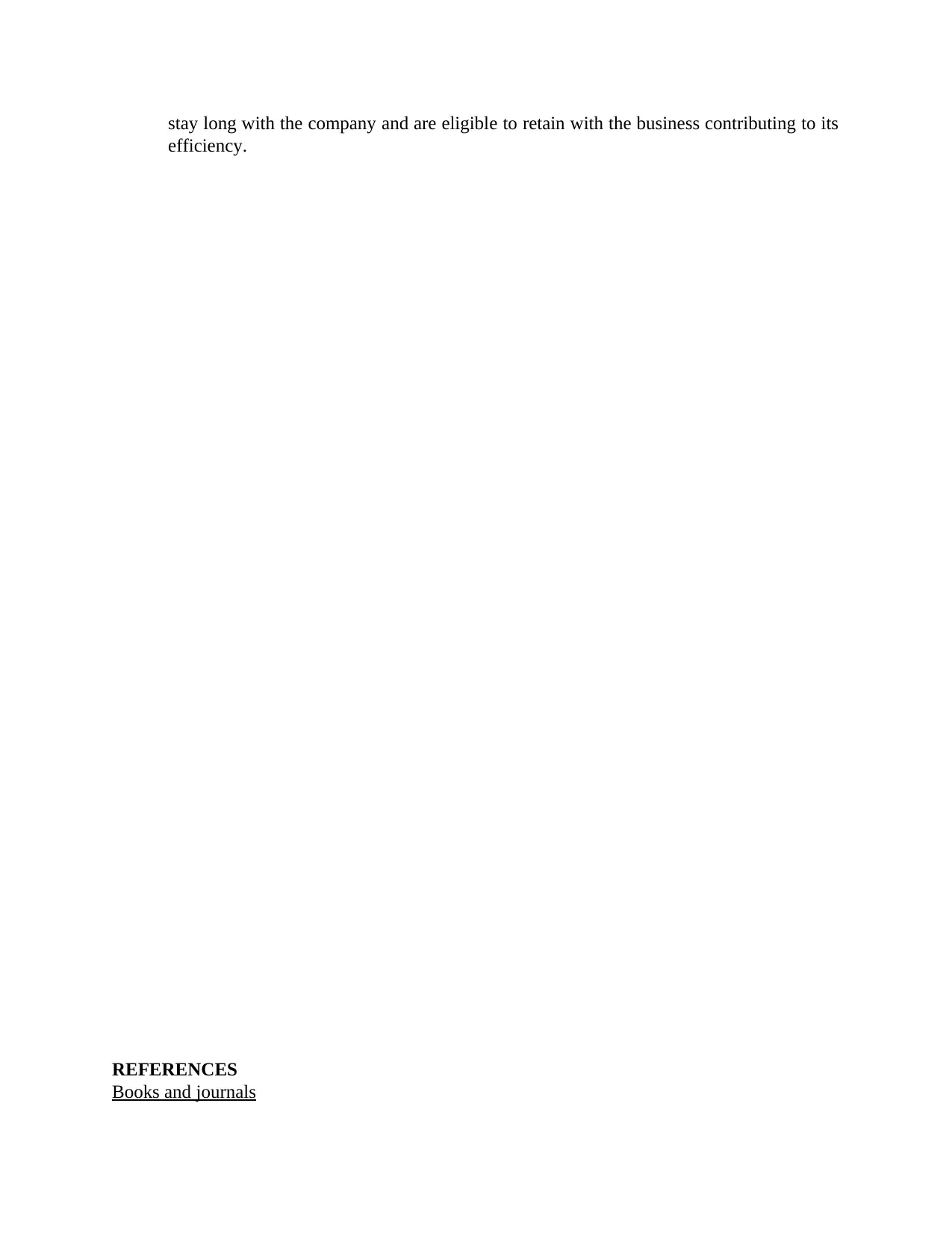
stay long with the company and are eligible to retain with the business contributing to its
efficiency.
REFERENCES
Books and journals
efficiency.
REFERENCES
Books and journals
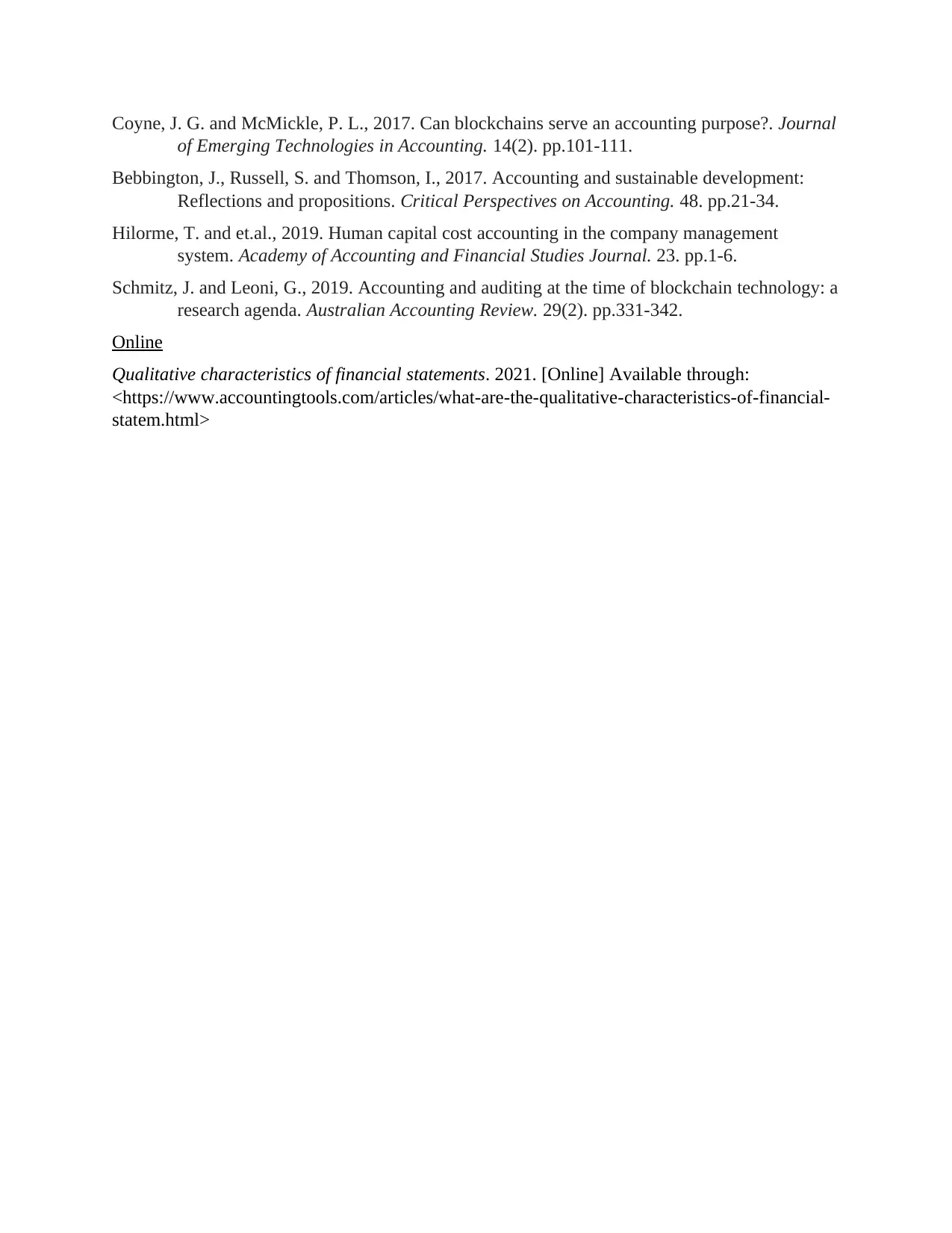
Coyne, J. G. and McMickle, P. L., 2017. Can blockchains serve an accounting purpose?. Journal
of Emerging Technologies in Accounting. 14(2). pp.101-111.
Bebbington, J., Russell, S. and Thomson, I., 2017. Accounting and sustainable development:
Reflections and propositions. Critical Perspectives on Accounting. 48. pp.21-34.
Hilorme, T. and et.al., 2019. Human capital cost accounting in the company management
system. Academy of Accounting and Financial Studies Journal. 23. pp.1-6.
Schmitz, J. and Leoni, G., 2019. Accounting and auditing at the time of blockchain technology: a
research agenda. Australian Accounting Review. 29(2). pp.331-342.
Online
Qualitative characteristics of financial statements. 2021. [Online] Available through:
<https://www.accountingtools.com/articles/what-are-the-qualitative-characteristics-of-financial-
statem.html>
of Emerging Technologies in Accounting. 14(2). pp.101-111.
Bebbington, J., Russell, S. and Thomson, I., 2017. Accounting and sustainable development:
Reflections and propositions. Critical Perspectives on Accounting. 48. pp.21-34.
Hilorme, T. and et.al., 2019. Human capital cost accounting in the company management
system. Academy of Accounting and Financial Studies Journal. 23. pp.1-6.
Schmitz, J. and Leoni, G., 2019. Accounting and auditing at the time of blockchain technology: a
research agenda. Australian Accounting Review. 29(2). pp.331-342.
Online
Qualitative characteristics of financial statements. 2021. [Online] Available through:
<https://www.accountingtools.com/articles/what-are-the-qualitative-characteristics-of-financial-
statem.html>
⊘ This is a preview!⊘
Do you want full access?
Subscribe today to unlock all pages.

Trusted by 1+ million students worldwide
1 out of 6
Related Documents
Your All-in-One AI-Powered Toolkit for Academic Success.
+13062052269
info@desklib.com
Available 24*7 on WhatsApp / Email
![[object Object]](/_next/static/media/star-bottom.7253800d.svg)
Unlock your academic potential
Copyright © 2020–2025 A2Z Services. All Rights Reserved. Developed and managed by ZUCOL.



